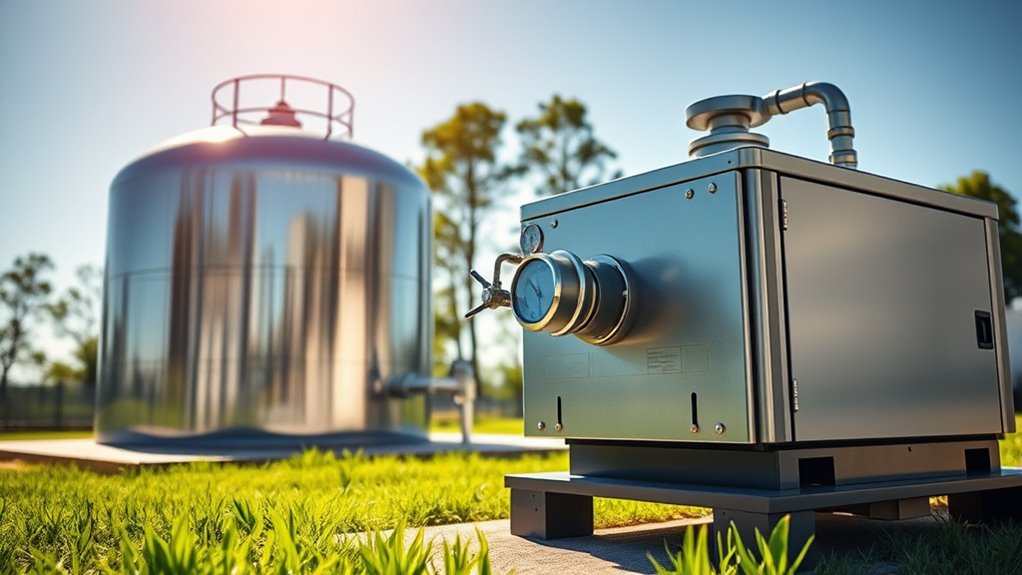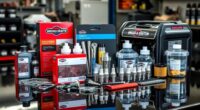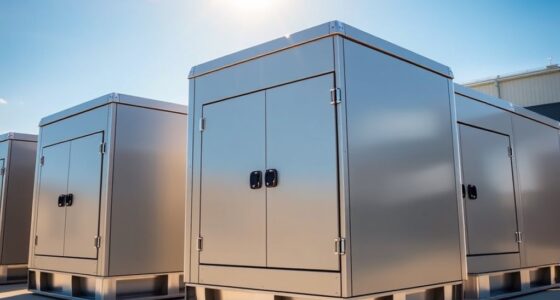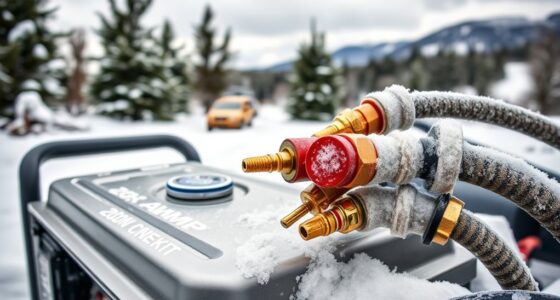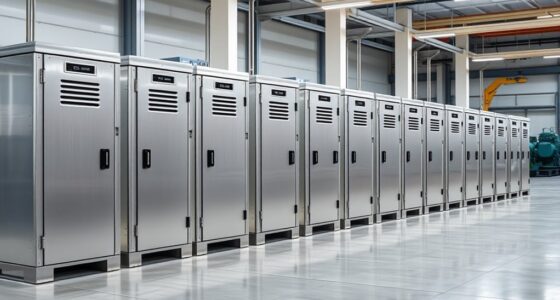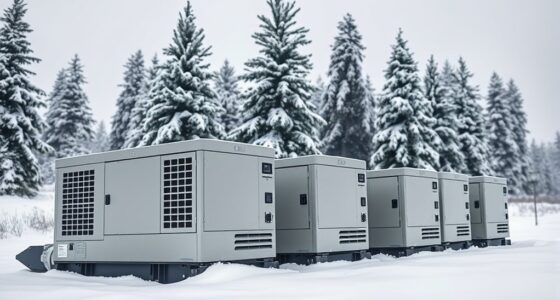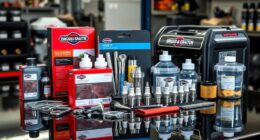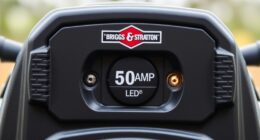To size a propane tank for your standby generator, start by figuring out your power needs and the generator’s fuel consumption rate at your expected load. Consider how long you want your backup power to run during outages. Larger tanks provide more capacity but need more space and safety planning. By understanding these factors, you can select the right tank size for reliable, safe operation—and if you keep exploring, you’ll gain even more confidence in your setup.
Key Takeaways
- Determine your generator’s wattage, runtime needs, and efficiency to accurately estimate propane fuel requirements.
- Calculate fuel consumption based on load levels and generator efficiency to select an appropriately sized tank.
- Consider space limitations and property constraints when choosing tank capacity—smaller for proximity, larger for expansion.
- Ensure tank size complies with local safety regulations, setback distances, and proper installation standards.
- Regularly inspect and maintain the tank to ensure safety, optimize fuel efficiency, and accommodate future energy needs.
Understanding Your Generator’s Power Needs

To properly size your propane tank, you first need to understand your generator’s power requirements. Knowing how much energy your generator consumes helps determine the right tank size and guarantees reliable operation. Fuel efficiency plays a key role, as more efficient generators use less fuel for the same output, impacting tank capacity. Consider your generator’s wattage and runtime needs to estimate daily fuel consumption accurately. Additionally, tank materials influence durability and safety; options like steel or composite materials can withstand weather and corrosion, extending your tank’s lifespan. By evaluating your generator’s power needs and understanding fuel efficiency and tank materials, you can select a propane tank that keeps your backup power system running smoothly without over- or under-sizing. Efficiency ratings are useful in assessing how well your generator converts fuel into power, further informing your tank size decision.
Calculating the Fuel Consumption Rate

Calculating the fuel consumption rate is essential for determining how long your propane tank will last during operation. To do this, you need to understand your generator’s fuel efficiency. Typically, fuel consumption depends on the load and efficiency analysis of your system. Use the following table as an example:
| Load Level | Fuel Consumption (Gallons/Hour) | Notes |
|---|---|---|
| 50% | 0.5 | Moderate load |
| 75% | 0.75 | High load |
| 100% | 1.0 | Full capacity |
Additionally, understanding how propane storage impacts your generator’s runtime can help optimize your setup.
Estimating Backup Run Time Requirements
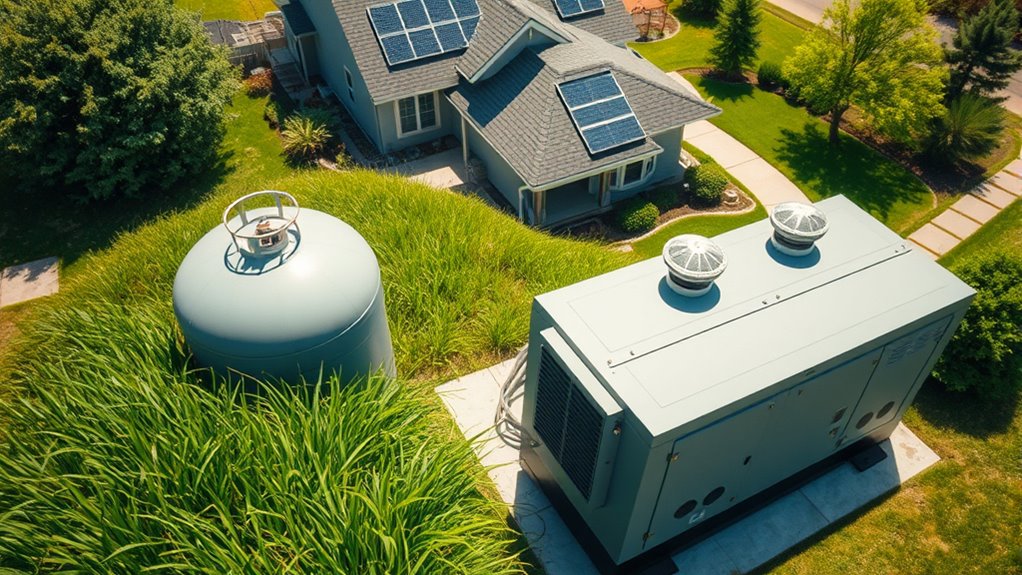
Understanding how long your backup generator needs to run is essential for selecting the right propane tank size. To estimate this, consider your power needs during outages and the typical duration of such events. Keep in mind that fuel stability is paramount; propane can degrade over time if not stored properly, affecting performance and safety. Also, think about the environmental impact—longer run times mean more emissions and resource use. By calculating the expected backup duration, you’ll better match the tank size to your needs, ensuring reliable power without excess fuel. Accurate estimates help optimize fuel use, reduce waste, and minimize environmental footprint. Additionally, assessing your bedroom energy consumption patterns can provide more precise guidance for sizing your tank. This step is vital for creating an efficient, safe, and eco-conscious standby generator system.
Determining the Appropriate Propane Tank Size
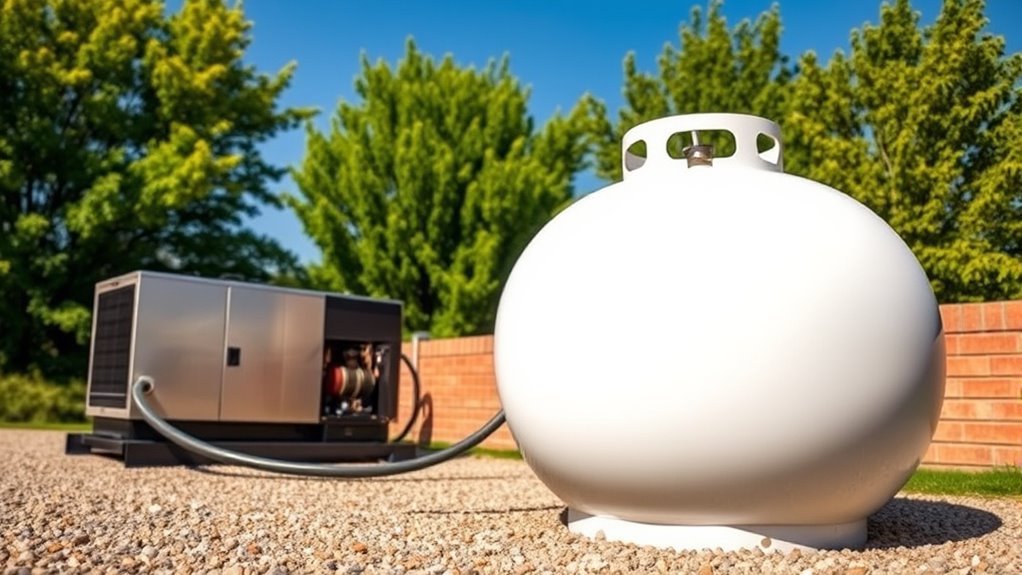
To select the right propane tank size, you need to precisely determine your fuel requirements based on your usage patterns. You should also consider space restrictions, since available area can limit your options. Making these assessments guarantees you pick a tank that fits your needs and your property. Additionally, understanding the different types of propane tanks for standby generators can help you choose the most suitable option for your setup.
Calculating Fuel Needs
Determining the right propane tank size starts with estimating your fuel consumption based on your specific needs. To do this accurately, consider your generator’s fuel efficiency—how much fuel it uses per hour at various loads. Calculate your expected runtime during outages, then multiply by the consumption rate to find total fuel requirements. Keep in mind that tank materials influence how efficiently the propane is stored and transferred; high-quality materials reduce leaks and evaporation, helping you get the most out of your fuel. Additionally, understanding the propane tank sizing process ensures you select an appropriately sized tank for your backup power needs. Knowing your daily or weekly consumption helps you select a tank size that provides sufficient backup without unnecessary excess. This approach ensures your generator runs reliably during power outages while avoiding over-purchasing or underestimating your fuel needs.
Considering Space Restrictions
When selecting a propane tank, space constraints often play a significant role in your decision. You need to take into account your installation location carefully, as limited space may restrict tank size options. The tank material also matters; steel tanks are durable and suitable for tight areas, while composite tanks can be more flexible for confined spaces. Measure the available area accurately to determine what fits comfortably without impeding access or safety zones. Keep in mind local codes and setback requirements, which can further influence your choice. If space is tight, a smaller tank might suffice temporarily, but ensure it meets your generator’s fuel needs. Additionally, choosing a sustainable fuel source can help minimize environmental impacts associated with traditional propane storage. Balancing size, safety, and installation location helps you choose the right tank for your setup.
Considering Safety and Regulatory Factors
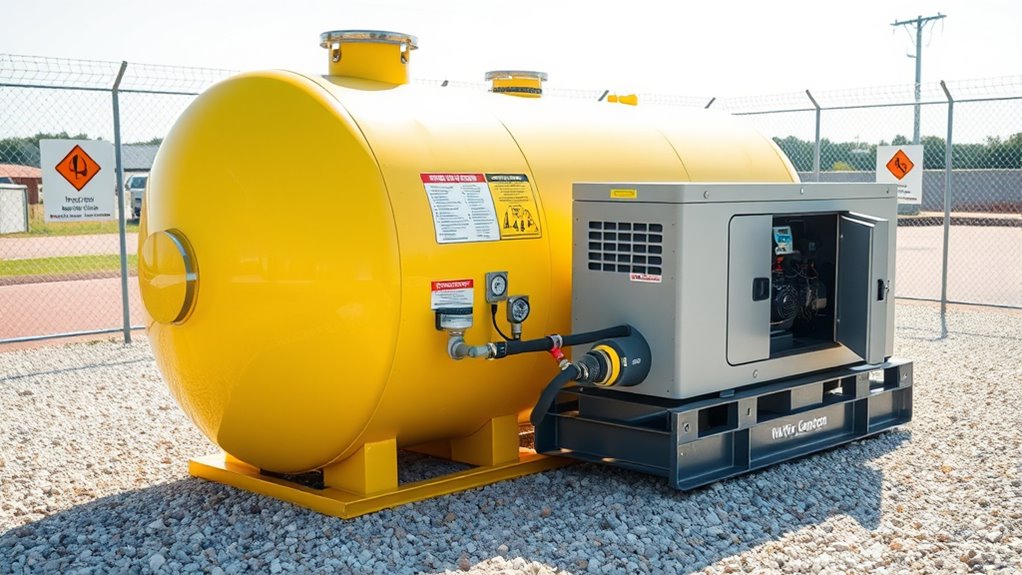
When sizing a propane tank, you need to guarantee safety and compliance with regulations. Make sure you understand local code requirements, safety storage guidelines, and industry standards. Meeting these factors ensures your setup remains safe and legally sound.
Regulatory Compliance Standards
Ensuring that propane tank sizes meet regulatory standards is vital for safety and compliance. Propane regulations establish clear guidelines to prevent hazards, guaranteeing proper storage safety. These standards specify maximum tank sizes, installation procedures, and distance requirements from structures and property lines. By adhering to these regulations, you minimize risks such as leaks, explosions, or fire hazards. It’s essential to verify local codes and federal standards when selecting tank sizes for your generator. Complying with regulatory requirements not only safeguards your property but also helps avoid fines or legal issues. Always consult with certified professionals to ensure your propane storage setup aligns with all safety and regulatory standards, giving you peace of mind and a secure, compliant system. Incorporating regulatory compliance standards into your planning process can further enhance safety and ensure your setup meets all necessary legal requirements.
Safety Storage Guidelines
Safety storage of propane tanks requires careful attention to both safety practices and regulatory guidelines to prevent accidents. You should choose a location that minimizes risks, such as avoiding areas prone to flooding or high traffic. Keep the tank’s aesthetics in mind by ensuring it’s discreet and visually unobtrusive, which helps maintain your property’s appearance. Proper ventilation is essential to reduce the environmental impact and prevent dangerous gas buildup. Never store propane tanks indoors or near ignition sources. Regularly inspect tanks for leaks, corrosion, or damage, and ensure they are properly secured. Following these safety storage guidelines not only protects your property but also promotes safe handling and environmental responsibility. Proper installation planning and adherence to safety standards are crucial for ensuring safe propane storage. Prioritizing safety and adherence to standards keeps everyone safe.
Local Code Requirements
Are you aware of the local codes that govern propane tank installation and storage? Understanding these regulations is essential for safe setup and operation. Local codes specify minimum distances from property lines, buildings, and ignition sources, ensuring safety during tank maintenance and emergencies. They also dictate tank size limits and venting requirements, which help prevent hazards. Regular tank maintenance, as mandated by local authorities, guarantees your system remains safe and compliant. Familiarize yourself with emergency procedures outlined in your local codes in case of leaks or fire. Staying compliant not only protects you and your property but also avoids fines or legal issues. Additionally, proper general ledger coding can streamline record-keeping related to your propane setup, ensuring accurate documentation for inspections and audits. Always consult local building departments or fire authorities to confirm your installation meets all safety and regulatory standards.
Practical Tips for Installing and Maintaining Your Tank

Proper installation and maintenance are essential to keep your propane tank safe and functioning efficiently. When doing tank installation, ensure it’s placed on a stable, level surface away from ignition sources and in compliance with local codes. Regular maintenance tips include checking for leaks, rust, or corrosion, and inspecting valves and connections for proper sealing. Keep the tank clear of debris and vegetation to prevent fire hazards. Schedule periodic professional inspections to catch potential issues early. Additionally, always follow manufacturer guidelines for tank care. Proper ventilation is also crucial to prevent dangerous gas buildup, such as carbon monoxide.
Making the Final Decision and Planning Ahead
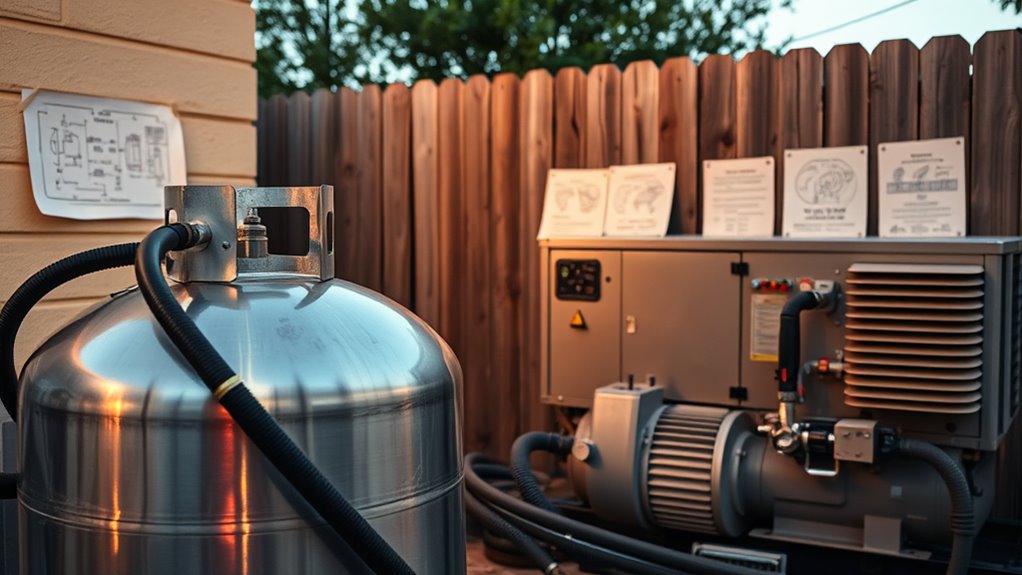
Before finalizing your propane tank purchase, it’s important to carefully evaluate your household’s needs, usage patterns, and available space. Decide on a tank location that’s accessible yet safe, considering proximity to your generator and ease of refilling. Think about future expansion; if you anticipate increased energy needs, plan for a larger tank or additional capacity now. Use the table below to compare options:
| Storage Capacity | Tank Location | Future Expansion Potential |
|---|---|---|
| Small (100-250 gal) | Near house, accessible | Limited scalability |
| Medium (250-500 gal) | Side yard, convenient | Moderate growth possible |
| Large (500+ gal) | Remote, secure area | Easy to expand or add tanks |
Planning ahead guarantees your setup remains efficient as your energy demands grow.
Frequently Asked Questions
How Often Should I Check My Propane Tank’s Pressure and Levels?
You should check your propane tank’s pressure and levels at least once a month to stay on top of tank maintenance. Regular pressure monitoring guarantees your generator runs smoothly during outages. If you notice any sudden drops in pressure or levels, it’s a good idea to inspect for leaks or other issues. Consistent checks help prevent unexpected failures and keep your standby generator ready when you need it most.
Can I Use a Larger Tank Than Recommended for Future Expansion?
Yes, you can use a larger tank than recommended for future expansion, but safety considerations are crucial. Opting for a bigger tank allows more propane storage, supporting increased demands. Just guarantee proper tank expansion procedures, like consulting a professional and following local codes, to prevent issues. Over-sizing can be beneficial, but always prioritize safety to avoid potential hazards or code violations.
What Are the Long-Term Costs Associated With Different Tank Sizes?
Choosing a larger tank might seem costly upfront, but it can lower your long-term costs by reducing refill frequency. Larger tanks require regular tank maintenance to prevent leaks and guarantee safety, which adds to expenses. Refill costs may also decrease per gallon with a bigger tank, but you’ll want to take into account whether the initial investment balances out with lower maintenance and refill costs over time.
How Does Climate Affect Propane Tank Performance and Safety?
Remember, a chain is only as strong as its weakest link. Climate influences propane tank performance and safety, especially through temperature fluctuations that can cause pressure changes. Wind erosion can wear down tank surfaces over time, risking leaks or failure. You should regularly inspect and maintain your tank, especially in extreme weather, to guarantee safety and peak performance. Proper precautions help you avoid costly problems down the road.
Are There Specific Regulations for Outdoor vs. Indoor Propane Tanks?
Yes, there are regulation differences between outdoor and indoor propane tanks. Outdoor tanks must follow stricter safety standards and are often required to be positioned away from buildings and vents. Indoor tanks need special safety features, like proper ventilation and leak detection. You should check local codes, as regulations vary by region, and verify your installation complies with all safety standards to prevent hazards and ensure safe operation.
Conclusion
Now that you’ve mastered propane tank sizing, remember, your backup power is only as reliable as the tank that holds it—unless, of course, you forget to check the fuel levels before a storm. Irony strikes when you realize all that planning might be moot if you overlook safety or regulatory guidelines. So, take a deep breath, double-check your setup, and enjoy peace of mind—until the power goes out, that is.
